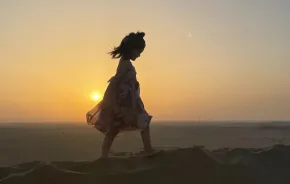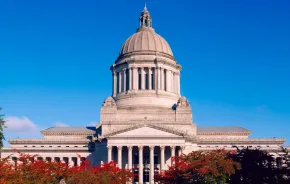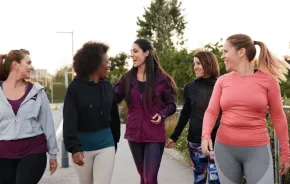Throughout the Puget Sound area, school colors — whether orange and blue, purple and gold or red and white — are gradually becoming green.
At home, kids put paper, glass, plastic bottles and cans into their specified containers without a thought. Some even haul the big green bin out to the curb on recycling day. Carrying that eco-attitude into the classroom was a no-brainer.
Years back, the green approach was left up to individual teachers. Marletta Iwasyk first introduced the concept of recycling to her kindergarten classroom at Seattle Public Schools’ Orca Elementary nearly 35 years ago. “We started by collecting glass and newspapers as a fundraiser,” says Iwasyk.
Orca kept up with the times, and in the early ‘90s created a community garden with edibles. The state awarded the school $10,000 that year for its recycling efforts.
Now, public and independent schools all around the Sound have jumped on the “green” bandwagon, adding recycling programs and finding ways of composting lunch scraps, aided in part by municipal programs.
School districts lead the way
Some local districts have implemented their own programs. Seattle Public Schools’ version, headed by resource conservation manager Nicole Riss, focuses on conserving resources and money. Each school must pay for trash disposal out of its operating budget; a savings can translate to more dollars spent on students.
The district’s TOPS (The Option Program at Seward) K–8 is one of the program’s success stories. Last year, as part of the fifth-grade science curriculum, students started composting their food waste. Parent volunteer Sandy Shettler helped set up the program, because she was shocked at the amount of food from school lunches going into the dumpsters. “It was great to see the fifth-graders get so involved,” she says. “They did a publicity campaign and a skit to introduce the program to the school community.” The students created posters with their own “Compost Man” and slogans like “Save the Earth.”
TOPS student Diasuke Fukagawa explains his role as part of the compost squad. “Our teachers taught us the basics of composting, so at lunch time we could direct the students to the right bins. It makes me feel better that I know I’m doing something for the environment … so we don’t fill up the landfills as fast as we can.”
Even with composting, TOPS still had too much trash, so the school extended the program to bring the three R’s (reduce, reuse, recycle) to all school events, from classroom celebrations to after-school parties.
To encourage less consumption, TOPS put together a party kit that includes hundreds of metal forks that can be reused. This year, parents will have the option of receiving the school’s biweekly newsletter online instead of by snail mail. This can save a potential of 40,000 sheets of paper a year — not to mention postage. So far, the school has cut back from two 5-cubic-yard dumpsters to one 8-cubic-yard dumpster; students and faculty hope to reduce that to a single 5-cubic-yard dumpster by the end of the 2008–09 school year.
Green Schools Program
Public and independent K–12 schools within King County — but outside the Seattle city limits — can participate in the county Solid Waste Division’s Green Schools Program. In operation since 2003, the program has grown from the pilot phase to a full-fledged movement, and has been adopted by nine school districts (reaching more than 200 schools), plus 33 individual public and independent schools. The county program provides the schools with assessments, tools and support necessary for program success.
The pilot phase included individual participants, such as independent Explorer West Middle School, located in unincorporated King County, and Tahoma School District’s Glacier Elementary.
In just its first year of participation, Glacier Elementary was able to reduce its lunch garbage volume from 80 to 36 bags per week by recycling milk boxes, juice cartons and aluminum cans. The effort was spearheaded by teacher Shandra Sciacqua, who formed a King County Green Team as an after-school class. Student members made recycling posters and monitored recycling in the lunchroom. To promote these efforts, they gave presentations to all the classrooms — with one of their members dressed as “green” alligator “Recycling Rick.”
Glacier’s principal, Emille Hard, notes that the students’ recycling efforts don’t stop at the school door. At school events, parents have been discussing the heightened awareness their children are bringing home. “One parent said her daughter was like the recycling police,” says Hard. “It’s a wonderful reflection that our efforts are paying off.”
The state steps up
Puget Sound-area schools outside King County can soon look to the state for assistance in going green. Marica Rutan, a Seattle Public Utilities employee, organized the Washington Green Schools Steering Team in 2005 after seeing the success of a similar program in Oregon.
“We want to build a culture in the state where green schools are the standard,” says Rutan. Funded by a grant from the Washington State Department of Ecology, the pilot is up and running, with 16 schools participating across the state. Plans are to make it available to all schools by fall 2009.
Each participating school will complete the program — all four phases — at its own pace. That self-directed component was what led Nancy Stillger, a parent volunteer at Seattle’s Holy Rosary School, to encourage the school community to sign up as a phase two participant.
“We formed a Green Team last year with a group of moms who were concerned about our carbon footprint and the amount of lunchroom trash,” explains Stillger. “We have a supportive principal — and the concept links in with the parish’s views on the environment and community.”
Stillger is delighted with the number of resources and assistance available. “There is so much out there,” she says.
In most cases, parents are key to a school’s success. With all the help available from various agencies, it’s heartening to see that green will soon become the common school color throughout the state. We can hear the cheers now … “Gimme a G!”
Andrea Leigh Ptak is a Seattle-based freelance writer.
Resources
Seattle Green Schools
A network for teachers, parents, school administrators and community members who want to make Seattle a little bit greener.
Seattle Public Schools
The district offers natural-resource conservation programs.
King County Green Schools Program
Join more than 200 schools and nine school districts that have participated in the King County Green Schools Program, improved conservation practices and received recognition.
Washington Green Schools
This four-phase program is offered to schools throughout Washington state.
The Green Schools Initiative
Here are seven steps to green your school.









